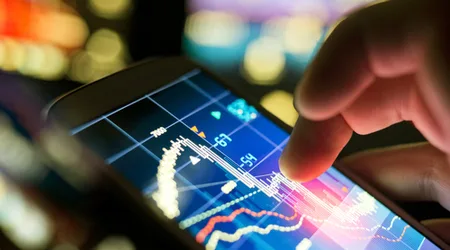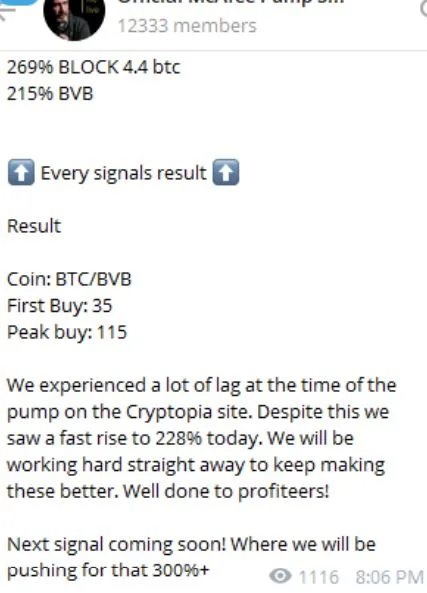Gone in 18 seconds: New study is a window into crypto pump and dump schemes

Researchers are pondering ways of trading on the market movements caused by pre-pumps.
The first Telegram group, Official McAfee Pump Signals, announced the chosen coin on 14 November 2018 at 19:30:04 GMT. It was an inactive coin called BVBCoin (BVB), created by fans of a German football team in 2016.
The first buy order was placed and completed 1 second after the announcement. 18 seconds later it was at its peak price of 118 satoshis.
And it was all downhill from there.
Not all pump groups were as fast. The Bomba bitcoin "cryptopia" group only announced it at 19:30:23, after it had peaked and was starting to plummet. It was all downhill from there, and the already-abandoned BVB was laid to rest when Cryptopia started the process of delisting the coin a week later. Three and a half minutes after it began, BVB was below its opening price and on the way to zero forever.
It's worth noting that the Cryptopia exchange almost certainly has nothing to do with these kinds of pump and dump (PnD) schemes. It might just happen to attract some of them as an unfortunate side effect of its extraordinarily wide cryptocurrency selection. But even Binance, with its relatively selective listing procedures and high volumes, has attracted a few pumps.
Not all exchanges are so clean though.
"Some exchanges are themselves directly associated with pump-and-dump. Yobit, for example, has openly organized pumps multiple times," explain Jiahua Xu and Benjamin Livshits from the Imperial College London in their new paper The Anatomy of a Pump-and-Dump Scheme (PDF).
The old Cryptopia BVB price charts still give a clear picture though.

Specifically, you can see how insiders started stocking up on BVB in the days leading up to the planned dump, and how the price peaked very briefly on 14 November (or 15 November on the chart and in New Zealand, where Cryptopia is based).
This is par for course in PnD groups, where everyone except the organisers themselves is intended to be a victim. The point of a pump and dump isn't just to artificially inflate prices, but also to momentarily boost demand to give the organisers an easy opportunity to unload near-worthless coins into a market that otherwise wouldn't have any demand.
Rules were made to be broken
Pump groups typically have a few rules, the researchers say. Typical rules of thumb, the researcher say, include to shill the coin during the pump to attract outsiders, "HODL the coin for at least several minutes to give outsiders time to join in" and "only sell at a profit and never below the current price".
That these kinds of schemes attract outsiders with FOMO is likely just a myth to obscure the fact that the PnD participants are the real outsiders. And holding on for several minutes is naturally ludicrous when coins reach their final peak in just a few seconds.
But none of this is a secret, the researchers note, and most participants seem perfectly aware that the pump group admins are trying to rip them off.
"So why are there still people enthusiastic about partaking in a pump, given the risk of being ripped off by the admins?" they ask. "Because people believe that there are greater fools out there, who would buy the coins at an even higher price than their original purchase price."
There probably aren't any greater fools out there, though, the research suggests. On the whole, it looks like the only victims are a tiny group of newcomers who get burnt once or twice and then learn their lesson.
Smoke and mirrors
The general vibe that pump organisers try to cultivate is one of carnival ebullience.

But this is also fake volume and, in fact, most pumps appear to just be a very small handful of new participants being gouged for the first or second time before they give up.
The BVB pump had over 1,300 views of the coin announcement to over 10,000 channel members. By contrast, the entire pump and dump consisted of only 322 transactions. You could probably count the number of actual pump and dump participants on your fingers, and it's likely that no one except the organiser(s) actually came out ahead.
While PnDs are often envisioned as a kind of group activity where you either get lucky or you don't, in reality, they're much more akin to a generic Nigerian prince email scam. Organisers try to engage people on social media or by any other channels and then bait them with the promise of more money later if they hand over a little bit of money now.
And just like those kinds of email scams, it's all a numbers game. Most people won't fall for it, and most of those who do will learn their lesson after the first or second time. Organisers need to constantly search for new victims, but only need one or two to profit from the scam.
So, actually participating in a PnD probably isn't any better a path to riches than replying to that nice man from Nigeria who just wants all your bank details so he can send you a million dollars.
There are larger PnDs too, the researchers note. But these are apparently dominated by trading bots which scan Telegram PnD channels and marketplaces for information, then automatically participate in statistically prudent ways.
As a general rule of thumb, anyone who tries participating in a PnD manually is likely en route to losing money.
Organising PnDs, meanwhile, sounds like a lot of work and is very much illegal. Blowing the whistle might be more easier and more profitable. If you have information that leads to successful actions against cryptocurrency pump and dump organisers, you can report it to the CFTC and may be eligible for a bounty of 10-30%.
These researchers have a different idea though, proposing an algorithm that aims to detect PnDs before they happen, and then using those predictions as the foundation of a rather unusual trading strategy.
"The model exhibits high precision as well as robustness, and can be used to create a simple, yet very effective trading strategy, which we empirically demonstrate can generate a return as high as 80% within a span of only three weeks," the researchers write.
Trading signals
The biggest part of the researcher's algorithm was the pre-pumping by PnD organisers.
"Previous analyses indicate unusual market movements prior to the pump and dump might signal organizers' pre-pump behavior, which could consequently give away the coin selection information. Therefore, we place great emphasis on features associated with market movements, such as price, returns and volatilities covering different lengths of time span. Those features, 46 in total, account to 85% of all the features considered."
These were found by looking at past market characteristics in the lead-up to a pump, and then reverse-engineering them. Although organisers filled their bags in the days leading up to pumps, there still tends to be a distinct buzz of market activity in the last hour before pumps, which can be used to guess when a pump is actually about to begin on a certain coin.
There are also characteristics of coins themselves, which indicate that something is more likely to be a chosen pumpee. BTC pairings are by far the most common – ETH pairs only account for a tiny fraction of PnD events – and pumpers naturally favour the lower cap coins with little volume, which they can actually move.
Previous returns are also correlated with pump likelihood, and a coin which has previously been hit with a PnD scheme is also more likely than another to get hit again. About 25% of the PnD events assessed by the researchers had been hit before.
The researchers note that they likely aren't the first to have come uncovered these factors (although they say that as far as they know they're the first to publish a paper on it), and suggest that other traders have already figured it out.
The main conclusion, they say, is that the right insider information makes it easy to gain an advantage over those victims in the pump groups, and that one doesn't necessarily have to be an insider to find that information in market movements pre-pump.
Latest cryptocurrency news
Picture: Shutterstock
